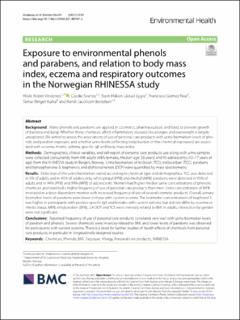| dc.contributor.author | Vindenes, Hilde Kristin | |
| dc.contributor.author | Svanes, Cecilie | |
| dc.contributor.author | Lygre, Stein Håkon Låstad | |
| dc.contributor.author | Real, Francisco Gomez | |
| dc.contributor.author | Ringel-Kulka, Tamar | |
| dc.contributor.author | Bertelsen, Randi Jacobsen | |
| dc.date.accessioned | 2022-03-28T11:58:04Z | |
| dc.date.available | 2022-03-28T11:58:04Z | |
| dc.date.created | 2022-01-28T14:47:51Z | |
| dc.date.issued | 2021 | |
| dc.identifier.issn | 1476-069X | |
| dc.identifier.uri | https://hdl.handle.net/11250/2988009 | |
| dc.description.abstract | Background
Many phenols and parabens are applied in cosmetics, pharmaceuticals and food, to prevent growth of bacteria and fungi. Whether these chemicals affect inflammatory diseases like allergies and overweight is largely unexplored. We aimed to assess the associations of use of personal care products with urine biomarkers levels of phenols and paraben exposure, and whether urine levels (reflecting body burden of this chemical exposures) are associated with eczema, rhinitis, asthma, specific IgE and body mass index.
Methods
Demographics, clinical variables, and self-report of personal care products use along with urine samples were collected concurrently from 496 adults (48% females, median age: 28 years) and 90 adolescents (10–17 years of age) from the RHINESSA study in Bergen, Norway. Urine biomarkers of triclosan (TCS), triclocarban (TCC), parabens and benzophenone-3, bisphenols and dichlorophenols (DCP) were quantified by mass spectrometry.
Results
Detection of the urine biomarkers varied according to chemical type and demographics. TCC was detected in 5% of adults and in 45% of adolescents, while propyl (PPB) and methyl (MPB) parabens were detected in 95% of adults and in 94% (PPB) and 99% (MPB) of adolescents. Women had higher median urine concentrations of phenolic chemicals and reported a higher frequency of use of personal care products than men. Urine concentration of MPB increased in a dose-dependent manner with increased frequency of use of several cosmetic products. Overall, urinary biomarker levels of parabens were lower in those with current eczema. The biomarker concentrations of bisphenol S was higher in participants with positive specific IgE and females with current asthma, but did not differ by eczema or rhinitis status. MPB, ethylparaben (EPB), 2,4-DCP and TCS were inversely related to BMI in adults; interaction by gender were not significant.
Conclusions
Reported frequency of use of personal care products correlated very well with urine biomarker levels of paraben and phenols. Several chemicals were inversley related to BMI, and lower levels of parabens was observed for participants with current eczema. There is a need for further studies of health effects of chemicals from personal care products, in particular in longitudinally designed studies. | en_US |
| dc.language.iso | eng | en_US |
| dc.publisher | BioMed Central | en_US |
| dc.rights | Navngivelse 4.0 Internasjonal | * |
| dc.rights.uri | http://creativecommons.org/licenses/by/4.0/deed.no | * |
| dc.title | Exposure to environmental phenols and parabens, and relation to body mass index, eczema and respiratory outcomes in the Norwegian RHINESSA study | en_US |
| dc.type | Journal article | en_US |
| dc.type | Peer reviewed | en_US |
| dc.description.version | publishedVersion | en_US |
| dc.rights.holder | Copyright 2021 The Author(s) | en_US |
| dc.source.articlenumber | 81 | en_US |
| cristin.ispublished | true | |
| cristin.fulltext | original | |
| cristin.qualitycode | 1 | |
| dc.identifier.doi | 10.1186/s12940-021-00767-2 | |
| dc.identifier.cristin | 1992658 | |
| dc.source.journal | Environmental health | en_US |
| dc.identifier.citation | Environmental health. 2021, 20 (1), 81. | en_US |
| dc.source.volume | 20 | en_US |
| dc.source.issue | 1 | en_US |

